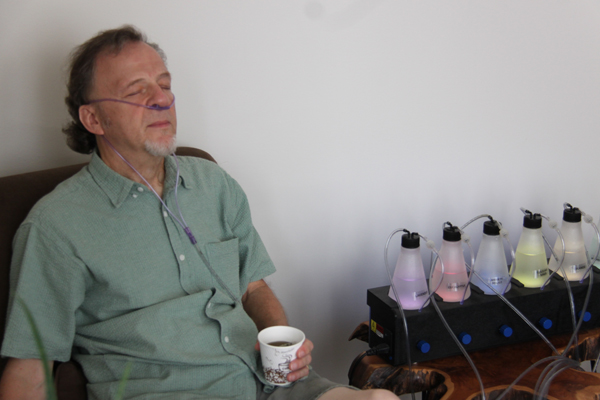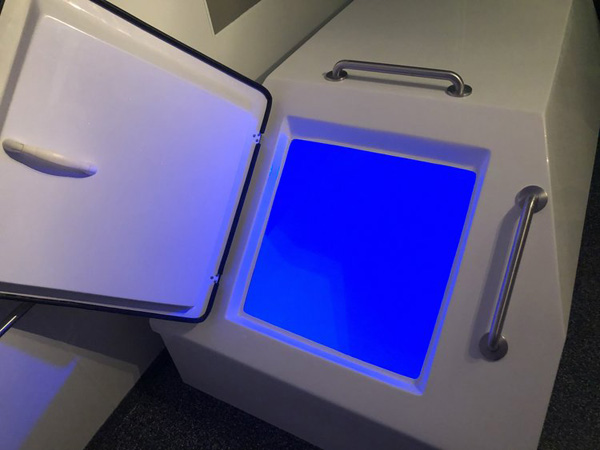
Those of you who were following this series—before we were so bizarrely interrupted by a pandemic—may recall that I had recently been exploring aspects of my womb journey. Having learned that my mom had a shortage of the amniotic fluid that might have provided a smoother ride if it had been more abundant, I had begun looking for clues that might connect my gestation in a shallow pool with my lifelong tendency to feel ill at ease, both emotionally and physically.
Having grown up in a good, stable home, well provided for, it was odd to consider myself as “traumatized” or “wounded.” But I knew I often felt uncomfortable in my skin, and had spent many hours pursuing these matters in a variety of counseling offices and emotional healing ministries. When tracing your own past, you can only backtrack so far . . . and the womb is the place where it all begins.
Birth educator Amanda Johnson, who consulted with me for previous installments of this series, affirmed that the float tank could indeed serve as a reasonably realistic surrogate womb. Having successfully led clients through visualizations designed to reimagine giving birth and help them move forward from traumatic birthing experiences (experienced as a mother, not as a newborn), she presented the possibility that I could flip-flop that healing exercise, re-envision my own birth, and possibly resolve trauma. I was intrigued. I deeply desired to experience more ease in my mind and body, which I’d gained in degrees over several months of visits to Float Alchemy. I’m willing to wager that those incremental gains had helped me to begin believing for a bigger dose.

As I prepared for a flotation session in which I would consciously try to reconnect with my pre-birth past, I still wasn’t sure how I might re-frame or re-visualize my gestation and birth. However, my preparation for the session also included a variety of reading material about the womb experience and potential trauma; the kinds of things that can go awry in the womb or impair the all-important bonding between mother and baby. As our “first home,” whatever happens in the womb can create future expectations and affect one’s sense of self—either positively or negatively—before even emerging as an independent creature.
Information I’d read, combined with what I’d learned from my mom, gave me a few things to work with. I learned that stress-related hormonal imbalances in the womb can reset the mother’s hypothalamus-pituitary-adrenal (HPA) axis. This can in turn alter the baby’s own HPA axis and reset the hypothalamus. The hypothalamus is a part of the brain that, for one, regulates the autonomic nervous system, which in turn regulates breathing. I have issues with shallow, irregular breathing. Hmmm.
Was there anything that might have been stressing my mom while she was carrying me, prompting her stress hormones to tip the scales? As it happens, there was. She developed back pain after giving birth to my older brother, and it returned with a vengeance while she was pregnant with me, requiring periods of bed rest. Having been unable to deliver my brother naturally, she also knew that a painful C-section would be necessary to bring me into the outside world. And, one day, dizzily getting out of bed for the guilty pleasure of a soda pop (ah, so that’s where my sweet tooth comes from . . . ), she took a nasty fall.
A stress-related hypothalamus reset in a gestating baby, I learned, can also trigger neurodevelopmental disorders such as Attention Deficit Disorder. I’d never been diagnosed, but I can tell you that I’ve long experienced difficulty maintaining attention span, ever since I was—HEY, LOOK! A SQUIRREL! Whoops . . . sorry. Where was I again?
As I attempt to explain all this, it occurs to me just how heavy and complex it can be. To be honest, there have been points in my exploration when I felt like maybe I was spending too much time in front of an inward-gazing microscope. Was I investing more energy in seeking clues than in just accepting mysteries of my being that may forever remain outside my understanding, and living my life as best I could?
Pardon me for a moment while I fast-forward the story.
During the past couple of months, when much of the world was on hiatus, I did in fact arrive at a place of acceptance. Just one day before Float Alchemy closed its doors for the safety of its clientele (despite the fact that it’s one of the most sanitary and least risky alternative health services imaginable), I made it into a tank and proceeded with my plan to “imagine” my womb experience. Even though the visualization approach has proven to be healing for others, based on information I’d been given, I felt it would be forced and perhaps inauthentic to try to re-imagine a more satisfying outcome. I wanted to embrace the reality of whatever might have intruded on my womb experience and impaired peaceful maternal bonding, and trust God with the whole thing.
The session (which I expect to detail in a future installment) didn’t produce any dramatic, “a-ha” moments, but it was fruitful, and not typical. I emerged feeling even calmer than I had after previous floats. Importantly, the material I’d been reading in preparation for the session had been speaking to me at both an intellectual and spiritual level; much of it combined scientific and psychological content about the womb experience with Bible scriptures that resonated with my Christian faith. And this is where the story potentially gets messy.

My intention for starting the Floativation series was twofold: first, to explore the realm of the sensory deprivation tanks that had intrigued me for decades, and second, to report on my findings with an eye toward benefiting others as well as Float Alchemy, the facility kindly hosting my journalistic explorations. When I began the process, I couldn’t have anticipated where it would take me. In retrospect, I believe that the opportunity to explore flotation as a healing modality was in fact an unexpected answer to prayer. It’s been a very enlightening and therapeutic experience, and Float Alchemy has provided a serene and emotionally safe environment on every occasion.
As I move forward with my own personal account, though, it becomes increasingly clear that the particulars of my story are downright unusual, involving my mother’s relatively rare condition of low amniotic fluid and my own unique responses, which I can still only presume may be a result of my womb experience. Combined with the particulars of my Christian faith and perspective on creation, one that not all individuals share, my story is unlikely to resonate equally with each person reading this.
So, please just hear this: floating has benefited me. Period. You don’t have to be searching out deep psychological, physiological or spiritual mysteries in order to receive relief, be it from from pain, tight muscles or stress. If you want to explore a new way to relax, especially in the current climate of the unknown, I wholeheartedly recommend that you consider floating as an option. I’m so sold on it that I’m willing to personally pay for a newcomer to try an hour in a float tank. If you’ve never tried floating, and you’d like to, post a message below or on the Pulse‘s Facebook page mentioning that you’ve read this installment of Floativation and that you’d like to visit Float Alchemy. Tell us how you think you might benefit, and what kind of relief or experience you’re hoping for. We’ll pick a winner and announce it in the next issue.
Stay tuned, Murfreesboro, and may the freedom of the float be with you.













